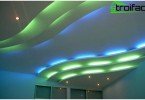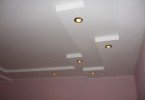What are the disadvantages of stretch ceilings
You can talk about the beauty of stretch ceilings for an infinitely long time, but conversation about their shortcomings, of which in reality turned out to be not so few, can be no less long. Manufacturers and installation companies are often silent and do not talk about the problems that may arise during the installation and operation of suspended ceilings. However, you need to be aware of all these points, because as they say: “The enemy must be known in person!” In this article, we will consider three things that you need to familiarize yourself with when choosing stretch ceilings in a store: reviews; flaws; problems.
Content
- The list of minuses of suspended ceilings
- Incompatibility with drywall elements
- Unpleasant effect of “cotton”
- Gulf and its consequences
- Deformation and sagging of the canvas
- Loss of ceiling height in the room
- Incompatible Lighting
- The difficulty of mounting additional devices
- Damage to piercing and cutting objects
- If unpleasant odor worries
The list of minuses of suspended ceilings
Incompatibility with drywall elements
Some of the drawbacks of suspended ceilings themselves have nothing to do with them. In this case, the problem is that during installation work, or rather when pulling the material, gypsum plasterboard sheets can tear off the walls. This is a completely natural process, because any stretch ceiling has a kind of tearing effect on the walls, the strength of which can reach 70 kg per linear meter.
Constructive solution to the problem
The situation is quite fixable if you pre-mount mortgages in the places where the baguette is fastened that will not let the drywall sheets come off.
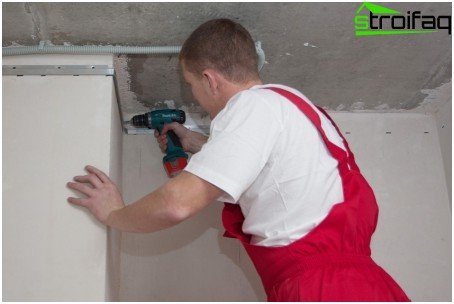
Installation of mortgages on drywall
There is a second solution to the problem: if the ceiling is lowered a considerable distance, then additional walls can be strengthened with the help of so-called “scarves”. Make them from boards or any other improvised material.
Unpleasant effect of “cotton”
Sometimes, opening a window or door, the effect of “popping” (collapse) occurs, which consists in pulling the vinyl film to the base of the ceiling. And at the moment of closing the door-window, a reverse reflex occurs. As a result, you can hear the clap. It is difficult to predict such a problem, but it can be stopped.
How to get rid of sound negativity
In this case, it is not difficult to get rid of intrusive sounds, but you should think about the possibility of their appearance in advance and buy the stretch ceiling that will definitely not “behave in this way”. The category of such finishing materials includes a seamless, non-stretch fabric ceiling..
If the stretch ceiling is already mounted, then the problem can be solved by equalizing the pressure in the ceiling and space. Experienced craftsmen will carry out this procedure without problems..
Gulf and its consequences
Any stretch ceilings – the flaws of the problem can still be solved – may be in the midst of flooding. In this case, rusty water from central heating batteries accumulates in the ceiling space and if its flow does not weaken, then it will begin to look for possible “escape routes”. The cutout under the chandelier or spotlights, the places where the ceiling is attached to the walls, are precisely the weak point of stretch ceilings. Having “found” these holes, water will rush into the apartment.
Seamless stretch ceilings from the water just sag, welded ones can go apart at the seams, fabric and completely let water through, which ultimately causes rust spots on the canvas. Think Before You Choose One Or Another Type Of Stretch Ceilings.
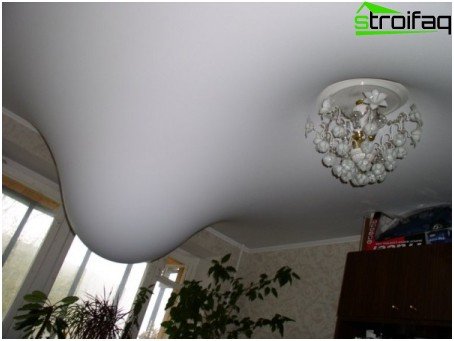
Stretch Ceiling Bay
What to do if you are flooded
- turn off the power to the apartment, because all wiring is hidden in the ceiling space and it is not known in what condition it is now;
- notify the neighbors from above and utilities about the bay;
- in places of leaks, place containers for collecting water;
- call the wizards to fix the problem.
To completely prevent this situation, you can seal the joints of the baguette and the walls. Then you will not be afraid of any leaks.
Deformation and sagging of the canvas
In small rooms, sagging the ceiling is an irrelevant problem. But in rooms the size of 20 square meters. m this issue is very acute. The maximum permissible degree of sagging for welded ceilings is 1% of the diagonal. This means that for 20 square meters. m of area is allowed to sag up to 4 cm. If this figure is larger, then the defect will be quite noticeable even with the naked eye.
How to eliminate sagging
The problem must be solved at the stage of repair planning. No sane installer will not install a stretch ceiling in a room measuring 50-100 square meters. m – this is simply not realistic, so be sure to first resolve this issue with the company that will be involved in the installation. You might find a different way to decorate your ceilings..
Sagging can be hidden. A ceiling has been installed for you, and after 3-5 years, you noticed that characteristic signs of “bubbling” or creases appeared in the chandelier area. Solves the problem by pulling the canvas.
Loss of ceiling height in the room
Any stretch ceilings – you can’t get any cons anywhere – “steal” precious centimeters of height. In general, for a good installation of the panel, 2-3 cm is enough, but in reality a little more comes out. This is due to the fact that the ceilings in apartments are almost always uneven: some corners can be lower or higher than others. Masters have to focus on the lowest of the corners and then it turns out that the stretch ceiling “steals” is no longer 2-3 cm from the planned, but all 5-7.
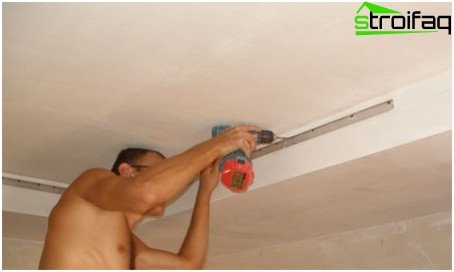
The stretch ceiling “steals” a few centimeters of height
How to minimize height loss
Unfortunately, it is impossible to solve this problem by cardinal methods – you will not break the ceiling. However, there is still a way out. Designers recommend using only pure white matte or satin fabrics, as they visually expand the space. In addition, forget about two-three-level ceilings – they will take the height and your kitchen-living room-bedroom will turn into a hut on chicken legs.
It’s not worth buying varnishes – the opinion that gloss adds volume erroneously.
And the last: use an ordinary chandelier and do not resort to additional lighting with the built-in spotlights – halogen lamps require lowering the ceiling by 5 cm, and lamps with incandescent lamps generally 9 cm.
Incompatible Lighting
Not every lamp is suitable for suspended ceilings, because for this category of finishing materials there is a limitation on the power of lighting devices.
There are three types of lamps:
- incandescent lamps – they are taken from a height of about 9-10 cm, but they are inexpensive and easy to replace;
- halogen lamps for 220 V;
- halogen transformer type lamps – for this type of lamp, it is advisable to install transformers in an easily accessible place – suddenly you have to replace them.
Solving the problem – competent selection
The problem is solved during the installation of lighting fixtures. Masters must provide for the thermal insulation of shades in the form of special rings. If this moment is missed, then after a few years a yellowish halo may appear around the lamps.
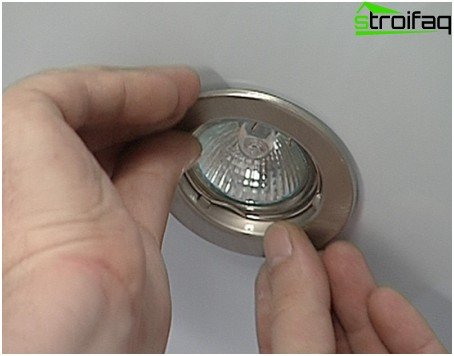
Choosing the right lighting fixtures is the key to a long stretch ceiling service
When choosing a lamp, choose 40 W traditional incandescent lamps, and 35-50 W halogen.
The difficulty of mounting additional devices
According to some reviews, we can conclude that consumers are not satisfied with the fact that the cornices have to be fastened only not to the wall. But as a rule, a modern cornice is made of light materials and gluing it to the wall will be enough.
But with built-in appliances (chandeliers, lamps) and various decorative elements, everything is much more complicated, because for their reliable fixation you will have to equip a “seat”. It would be nice to decide in advance where and what you will have so that the craftsmen can immediately prepare the places for fastening. But what if the desire to decorate your ceiling with stucco molding arose after the installation of the ceiling? Just inform the company that was installing your ceiling about your intention. Specialists will come and, having sorted out part of the canvas, will establish “seats”. It’s not that complicated!
Damage to piercing and cutting objects
This is perhaps the most egregious problem of all, because for some reason everyone thinks that the stretch ceiling is very easy to pierce. Indeed, if you make certain efforts (throwing knives and forks at the ceiling, skiing around the apartment and waving poles, etc.), the canvas will not stand and will tear. But if you lead a normal lifestyle, then even childish pranks or a champagne cork flying in free flight will not be able to damage your ceiling.
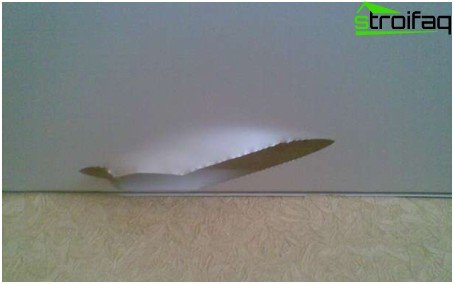
Damage to the stretch ceiling is the most pressing issue.
However, there are times when a hole still appears on the panel.
Prevention of spoilage
- If the cut is located near the wall, then simply pull the blade to the guide.
- If the hole was formed far from the wall and has small (up to 2-3 cm) dimensions, then you can glue a patch of the same material from which the ceiling is made, or try to sew a hole with nylon threads.
- Alternatively, you can seal the damaged area with a beautiful application..
If unpleasant odor worries
An unpleasant odor is manifested even at the stage of “warming up” the canvas with a gas burner. However, if the ceiling is of high quality, then such a “defect” will resolve itself after 3-5 days, but if you bought the cheapest option, then you will live in the neighborhood with the “aroma” much longer. It is worth knowing that this smell is not dangerous, but still being in a room that smells like a Chinese shop is not very pleasant.
It is impossible to solve this problem for vinyl ceilings. With fabric stretch ceilings, nothing like this threatens you, so if environmental friendliness is paramount for you, then choose fabric materials.
Based on this information, you can choose for yourself just such stretch ceilings – you now know the shortcomings of the drawbacks – which will meet all your requirements. And it’s possible that even after 10 years your ceiling will not sag, will not turn yellow and will not lose a drop of its beauty.



